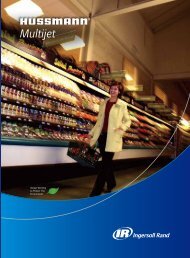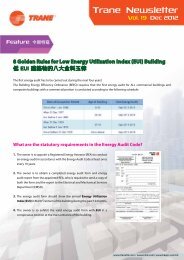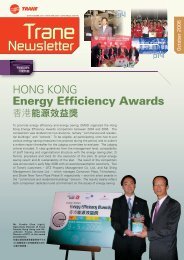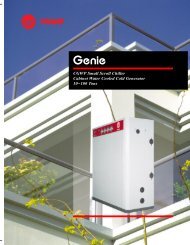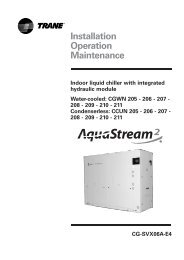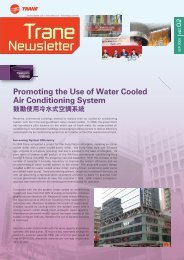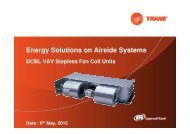Effects of Altitude on Psychrometric Calculations and Fan Selection ...
Effects of Altitude on Psychrometric Calculations and Fan Selection ...
Effects of Altitude on Psychrometric Calculations and Fan Selection ...
You also want an ePaper? Increase the reach of your titles
YUMPU automatically turns print PDFs into web optimized ePapers that Google loves.
providing insights for today’s hvac system designerEngineers Newslettervolume 39 –4<str<strong>on</strong>g>Effects</str<strong>on</strong>g> <str<strong>on</strong>g>of</str<strong>on</strong>g> <str<strong>on</strong>g>Altitude</str<strong>on</strong>g><strong>on</strong> psychrometric calculati<strong>on</strong>s <strong>and</strong> fan selecti<strong>on</strong>sFor this EN we're pulling from thearchives to address a subject thatstill causes c<strong>on</strong>fusi<strong>on</strong> within theindustry <strong>and</strong> c<strong>on</strong>tinues to be thesubject <str<strong>on</strong>g>of</str<strong>on</strong>g> frequently askedquesti<strong>on</strong>s. This EN investigates theeffects <str<strong>on</strong>g>of</str<strong>on</strong>g> altitude <strong>on</strong> psychrometriccalculati<strong>on</strong>s <strong>and</strong> fan selecti<strong>on</strong>s."St<strong>and</strong>ard Air"As altitude increases, the averagebarometric pressure drops <strong>and</strong> airdensity decreases."St<strong>and</strong>ard air" has historically beendefined by ASHRAE as having adensity <str<strong>on</strong>g>of</str<strong>on</strong>g> 0.075 lb/ft 3 , whichequates to air density at sea level(barometric pressure <str<strong>on</strong>g>of</str<strong>on</strong>g> 29.92 in.Hg). The 2009 ASHRAE H<strong>and</strong>book<str<strong>on</strong>g>of</str<strong>on</strong>g> Fundamentals (page 18.13) statesthat this c<strong>on</strong>diti<strong>on</strong> is represented byeither saturated air at 60°F dry bulbor dry air at 69°F dry bulb.Since the performance <str<strong>on</strong>g>of</str<strong>on</strong>g> heating,cooling, <strong>and</strong> air-moving equipment iscomm<strong>on</strong>ly rated at "st<strong>and</strong>ard air"c<strong>on</strong>diti<strong>on</strong>s, cataloged performancedata cannot be used directly forhigher altitude applicati<strong>on</strong>s. Forinstance, at a barometric pressure <str<strong>on</strong>g>of</str<strong>on</strong>g>24 in. Hg (approximately 6000 ftaltitude), cataloged data may be <str<strong>on</strong>g>of</str<strong>on</strong>g>fby as much as 20 to 40 percent.While areas above 6000 ft arestatistically limited, a number <str<strong>on</strong>g>of</str<strong>on</strong>g>states <strong>and</strong> cities have barometricpressures in the range <str<strong>on</strong>g>of</str<strong>on</strong>g> 29 to 27 in.Hg. In this range, cataloged ratings maydiffer from actual c<strong>on</strong>diti<strong>on</strong>s by 3 to 20percent.<strong>Psychrometric</strong> Calculati<strong>on</strong>sThe equati<strong>on</strong>s used in psychrometriccalculati<strong>on</strong>s remain the same for allaltitudes. However, some <str<strong>on</strong>g>of</str<strong>on</strong>g> the factorsused in these equati<strong>on</strong>s are affected byaltitude.The sensible heat gain (Q s ) equati<strong>on</strong> is<str<strong>on</strong>g>of</str<strong>on</strong>g>ten displayed as follows:Q s = 1.085 × cfm × THowever, the 1.085 in this equati<strong>on</strong> isnot a c<strong>on</strong>stant. Rather, it is the product<str<strong>on</strong>g>of</str<strong>on</strong>g> the density () <strong>and</strong> specific heat (C p )<str<strong>on</strong>g>of</str<strong>on</strong>g> the air at "st<strong>and</strong>ard air" c<strong>on</strong>diti<strong>on</strong>s,<strong>and</strong> the c<strong>on</strong>versi<strong>on</strong> factor <str<strong>on</strong>g>of</str<strong>on</strong>g> 60 minutesper hour.Q s = ( × C p × 60 min/hr) × cfm x TThe specific heat for 69°F dry air at sealevel is 0.241 Btu/lb°F. Therefore, at"st<strong>and</strong>ard air" c<strong>on</strong>diti<strong>on</strong>s, theseproperties result in the value 1.085.0.075 lb/ft 3 × 0.241 Btu/lb°F × 60 min/hr= 1.085© 2010 Trane, a business <str<strong>on</strong>g>of</str<strong>on</strong>g> Ingersoll R<strong>and</strong>. All rights reserved. 1
The latent heat gain (Q L ) equati<strong>on</strong> is<str<strong>on</strong>g>of</str<strong>on</strong>g>ten displayed as follows:Figure 1. Air density ratiosQ L = 0.69 × cfm × W (gr/lb)Elevati<strong>on</strong>Sea level1000 ft.2000 ft.3000 ft.4000 ft.5000 ft.6000 ft.7000 ft.Barometer29.92 in. Hg.28.86 in. Hg.27.82 in. Hg.26.81 in. Hg.25.84 in. Hg.24.89 in. Hg.23.98 in. Hg.23.09 in. Hg.However, the 0.69 in this equati<strong>on</strong> isnot a c<strong>on</strong>stant. Rather, it is the product<str<strong>on</strong>g>of</str<strong>on</strong>g> the density <strong>and</strong> latent heat <str<strong>on</strong>g>of</str<strong>on</strong>g>vaporizati<strong>on</strong> (h vap ) <str<strong>on</strong>g>of</str<strong>on</strong>g> the air at"st<strong>and</strong>ard air" c<strong>on</strong>diti<strong>on</strong>s, <strong>and</strong> thec<strong>on</strong>versi<strong>on</strong> factors <str<strong>on</strong>g>of</str<strong>on</strong>g> 60 minutes perhour <strong>and</strong> 7000 grains/lb.Q L = (× h vap × 60 min/hr / 7000 gr/lb)× cfm × WThe latent heat <str<strong>on</strong>g>of</str<strong>on</strong>g> vaporizati<strong>on</strong> for 69°Fdry air at sea level is 1076 Btu/lb.Therefore, at "st<strong>and</strong>ard air" c<strong>on</strong>diti<strong>on</strong>s,these properties result in the value0.69.Air Density Ratio(0.075 lb/ft 3 × 1076 Btu/lb × 60 min/hr) /7000 gr/lb = 0.69The total heat gain (Q T ) equati<strong>on</strong> is<str<strong>on</strong>g>of</str<strong>on</strong>g>ten displayed as follows:Q T = 4.5 × cfm × hHowever, the 4.5 in this equati<strong>on</strong> is nota c<strong>on</strong>stant. Rather, it is the product <str<strong>on</strong>g>of</str<strong>on</strong>g>the density <str<strong>on</strong>g>of</str<strong>on</strong>g> the air at "st<strong>and</strong>ard air"c<strong>on</strong>diti<strong>on</strong>s <strong>and</strong> the c<strong>on</strong>versi<strong>on</strong> factor <str<strong>on</strong>g>of</str<strong>on</strong>g>60 minutes per hour.Air Temperature, ºFQ T = ( × 60 min/hr) × cfm × hFor "st<strong>and</strong>ard air" density, the result isthe value 4.5.0.075 lb/ft 3 × 60 min/hr = 4.5Air at other c<strong>on</strong>diti<strong>on</strong>s <strong>and</strong> otheraltitudes will cause these factors tochange.<strong>Fan</strong>s<strong>Fan</strong>s are c<strong>on</strong>sidered to be c<strong>on</strong>stantvolumedevices. That is, a given fan willdeliver a specific volumetric flow rate(cfm) at a specific fan rotati<strong>on</strong>al speed(rpm). The mass <str<strong>on</strong>g>of</str<strong>on</strong>g> air that the fanmoves at a given speed will vary based<strong>on</strong> the density <str<strong>on</strong>g>of</str<strong>on</strong>g> the air being moved.Air density also changes the staticpressure that the fan will develop <strong>and</strong>the horsepower needed to drive it.<strong>Fan</strong> <strong>and</strong> air h<strong>and</strong>ler manufacturerstypically catalog fan performance dataat "st<strong>and</strong>ard air" c<strong>on</strong>diti<strong>on</strong>s. If theairflow requirement for a givenapplicati<strong>on</strong> is stated at n<strong>on</strong>-st<strong>and</strong>ardc<strong>on</strong>diti<strong>on</strong>s, a density correcti<strong>on</strong> mustbe made prior to selecting a fan.The procedure for selecting a fan atactual altitude (or temperatures) isoutlined in the following steps:1 Determine the actual air density<strong>and</strong> calculate the air density ratio,which is the density at actualc<strong>on</strong>diti<strong>on</strong>s divided by density atst<strong>and</strong>ard c<strong>on</strong>diti<strong>on</strong>s. Figure 1provides a useful chart fordetermining the air density ratiobased <strong>on</strong> altitude <strong>and</strong> airtemperature.Air Density Ratio =2 Divide the design static pressure atactual c<strong>on</strong>diti<strong>on</strong>s by the air densityratio determined in Step 1.SP st<strong>and</strong>ard =SP actualDensity actualDensity st<strong>and</strong>ardAir Density Ratio3 Use the actual design airflow (cfm)<strong>and</strong> the static pressure correctedfor st<strong>and</strong>ard c<strong>on</strong>diti<strong>on</strong>s (see Step 2)to select the fan from theperformance tables/charts <strong>and</strong> todetermine the speed (rpm) <strong>and</strong>horsepower requirement <str<strong>on</strong>g>of</str<strong>on</strong>g> the fanat st<strong>and</strong>ard c<strong>on</strong>diti<strong>on</strong>s.4 The fan speed (rpm) is the same atboth actual <strong>and</strong> st<strong>and</strong>ardc<strong>on</strong>diti<strong>on</strong>s.RPM actual = RPM st<strong>and</strong>ard5 Multiply the input powerrequirement by the air density ratioto determine the actual inputpower required. Power actual = Air Density Ratio X Power st<strong>and</strong>ard2 Trane Engineers Newsletter volume 39–4 providing insights for today’s HVAC system designer
It is important to note that mostpressure-loss charts for othersystem comp<strong>on</strong>ents (such asducts, filters, coils, <strong>and</strong> dampers)are also based <strong>on</strong> st<strong>and</strong>ard airc<strong>on</strong>diti<strong>on</strong>s.SummaryAlthough the wide-scale use <str<strong>on</strong>g>of</str<strong>on</strong>g>computer s<str<strong>on</strong>g>of</str<strong>on</strong>g>tware to select HVACequipment has made the process <str<strong>on</strong>g>of</str<strong>on</strong>g>correcting for altitude simpler, afundamental underst<strong>and</strong>ing is stillimportant to prevent mistakes <strong>and</strong>troubleshoot problems.By Trane Applicati<strong>on</strong>s Engineering. You can findthis <strong>and</strong> previous issues <str<strong>on</strong>g>of</str<strong>on</strong>g> the EngineersNewsletter at www.trane.com/engineersnewsletter. To comment, e-mail us atcomfort@trane.com.View the latest <strong>on</strong>-dem<strong>and</strong>courses:ASHRAE St<strong>and</strong>ard 90.1-2010.Energy-Saving Strategies forRo<str<strong>on</strong>g>of</str<strong>on</strong>g>top VAV Systems.ASHRAE St<strong>and</strong>ard 62.1: Ventilati<strong>on</strong>Rate Procedure.LEED 2009 Modeling <strong>and</strong> EnergySavings.The courses were developed <strong>and</strong> are<str<strong>on</strong>g>of</str<strong>on</strong>g>fered free <str<strong>on</strong>g>of</str<strong>on</strong>g> charge to dem<strong>on</strong>strateTrane’s commitment to sustainabledesign. LEED Accredited Pr<str<strong>on</strong>g>of</str<strong>on</strong>g>essi<strong>on</strong>als(APs) <strong>and</strong> AIA members can participate<strong>and</strong> earn an average <str<strong>on</strong>g>of</str<strong>on</strong>g> 1.5 C<strong>on</strong>tinuingEducati<strong>on</strong> (CE) hours per program.Visit www.trane.com/c<strong>on</strong>tinuingeducati<strong>on</strong> to view allcurrent courses <strong>and</strong> details.3 Trane Engineers Newsletter volume 39–4 providing insights for today’s HVAC system designer
New applicati<strong>on</strong> manualsnow availableCentral Geothermal Design <strong>and</strong>C<strong>on</strong>trol. (SYS-APM009-EN, April 2010)Chilled-Water VAV Systems. (SYS-APM008-EN, August 2009)Chiller System Design <strong>and</strong> C<strong>on</strong>trol.(SYS-APM001-EN, May 2009)Visit www.trane.com/bookstore toorder <strong>and</strong> view a complete list <str<strong>on</strong>g>of</str<strong>on</strong>g>resources.EngineersNewsletterLIVE!To register, c<strong>on</strong>tact yourlocal Trane <str<strong>on</strong>g>of</str<strong>on</strong>g>fice.March 2011Upgrading ExistingChilled-WaterSystemsJune 2011High-PerformanceVAV SystemsOctober 2011DedicatedOutdoor Air UnitsTrane,A business <str<strong>on</strong>g>of</str<strong>on</strong>g> Ingersoll R<strong>and</strong>For more informati<strong>on</strong>, c<strong>on</strong>tact your local Trane<str<strong>on</strong>g>of</str<strong>on</strong>g>fice or e-mail us at comfort@trane.comTrane believes the facts <strong>and</strong> suggesti<strong>on</strong>s presented here to be accurate. However, final design <strong>and</strong>applicati<strong>on</strong> decisi<strong>on</strong>s are your resp<strong>on</strong>sibility. Trane disclaims any resp<strong>on</strong>sibility for acti<strong>on</strong>s taken <strong>on</strong>the material presented.4 Trane Engineers Newsletter volume 39–4 ADM-APN039-EN (December 2010)




